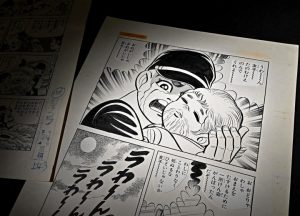Documenting Hiroshima of 1945: Around November, younger sister born on August 6 dies
Nov. 26, 2024
by Minami Yamashita, Staff Writer
Around November 1945, Keiji Nakazawa, six at the time, who later became a manga artist and died in 2012 at the age of 73, lost his younger sister, Tomoko, who was born on August 6. His mother, Kimiyo, went into labor immediately after the atomic bombing and gave birth on the street. However, unable to produce much breast milk, she fed her daughter rice gruel.
Mr. Nakazawa, who experienced the atomic bombing near the school gate of Kanzaki National School (present-day Kanzaki Elementary School, in Hiroshima’s Naka Ward), had lost his father, older sister, and younger brother in the collapse of their house in the area of Funairi-honmachi. When he was reunited with his mother, who had managed to escape, “She was holding a tattered piece of cloth to her chest as if it were something precious. When I looked at the cloth to see what it was, I saw that there was a baby inside with a wrinkled, red face,” as he described in the manga Hadashi no Gen: Watashi no Isho (in English, “Barefoot Gen: My Last Will”), published in 2012.
After the end of the war, Mr. Nakazawa’s family of five, including his two older brothers, stayed with a relative in the Eba district (in Hiroshima’s present-day Naka Ward). In the place of his mother, who was working outside the home, Mr. Nakazawa would look after his younger sister. He would press his cheek against hers, soak gauze-wrapped cotton in rice gruel, and make her suck on it.
Because of food shortages, the family used to collect clams and seaweed from rivers in the city. However, with his mother unable to produce breast milk, the baby died about three months after her birth. In the manga My Last Will, Mr. Nakazawa described how, just before dying, his sister had been crying loudly, and “when I thought she had fallen asleep, she had in fact died. It was such a shock. I thought to myself, ‘She just wanted to have some milk.’” The family cremated the body on the seashore.
His mother Kimiyo raised the three remaining children and died in 1966 at the age of 60. His wife, Misayo, 82, a resident of Tokorozawa City in Saitama Prefecture who had just married Mr. Nakazawa, described the scene after his mother’s funeral in Hiroshima City. “My mother-in-law had no proper bones left, and my husband did not speak a single word until we returned to Tokyo. He must have been exploding in anger that even her bones had been destroyed by the radiation.”
Two years later, that situation prompted Mr. Nakazawa to create the manga Kuroi Ame ni Utarete (‘Struck by Black Rain’), his first work based on the atomic bombing. His “anger toward the atomic bombing” would lead to his signature work Barefoot Gen.
(Originally published on November 26, 2024)
Around November 1945, Keiji Nakazawa, six at the time, who later became a manga artist and died in 2012 at the age of 73, lost his younger sister, Tomoko, who was born on August 6. His mother, Kimiyo, went into labor immediately after the atomic bombing and gave birth on the street. However, unable to produce much breast milk, she fed her daughter rice gruel.
Mr. Nakazawa, who experienced the atomic bombing near the school gate of Kanzaki National School (present-day Kanzaki Elementary School, in Hiroshima’s Naka Ward), had lost his father, older sister, and younger brother in the collapse of their house in the area of Funairi-honmachi. When he was reunited with his mother, who had managed to escape, “She was holding a tattered piece of cloth to her chest as if it were something precious. When I looked at the cloth to see what it was, I saw that there was a baby inside with a wrinkled, red face,” as he described in the manga Hadashi no Gen: Watashi no Isho (in English, “Barefoot Gen: My Last Will”), published in 2012.
After the end of the war, Mr. Nakazawa’s family of five, including his two older brothers, stayed with a relative in the Eba district (in Hiroshima’s present-day Naka Ward). In the place of his mother, who was working outside the home, Mr. Nakazawa would look after his younger sister. He would press his cheek against hers, soak gauze-wrapped cotton in rice gruel, and make her suck on it.
Because of food shortages, the family used to collect clams and seaweed from rivers in the city. However, with his mother unable to produce breast milk, the baby died about three months after her birth. In the manga My Last Will, Mr. Nakazawa described how, just before dying, his sister had been crying loudly, and “when I thought she had fallen asleep, she had in fact died. It was such a shock. I thought to myself, ‘She just wanted to have some milk.’” The family cremated the body on the seashore.
His mother Kimiyo raised the three remaining children and died in 1966 at the age of 60. His wife, Misayo, 82, a resident of Tokorozawa City in Saitama Prefecture who had just married Mr. Nakazawa, described the scene after his mother’s funeral in Hiroshima City. “My mother-in-law had no proper bones left, and my husband did not speak a single word until we returned to Tokyo. He must have been exploding in anger that even her bones had been destroyed by the radiation.”
Two years later, that situation prompted Mr. Nakazawa to create the manga Kuroi Ame ni Utarete (‘Struck by Black Rain’), his first work based on the atomic bombing. His “anger toward the atomic bombing” would lead to his signature work Barefoot Gen.
(Originally published on November 26, 2024)








